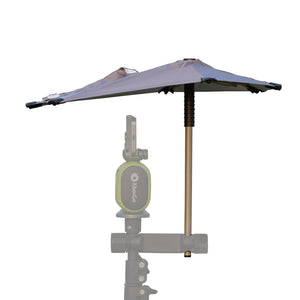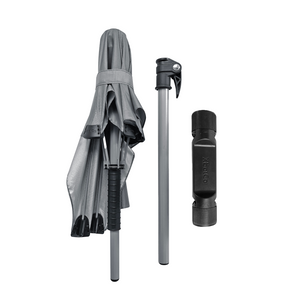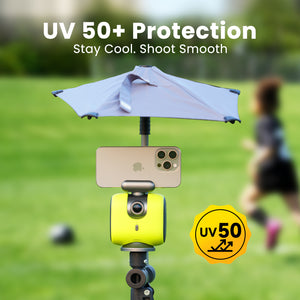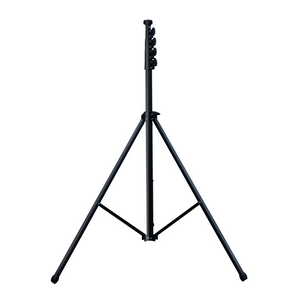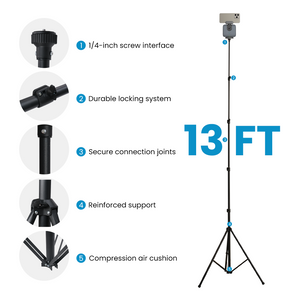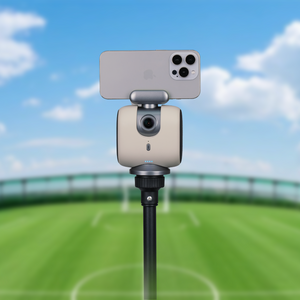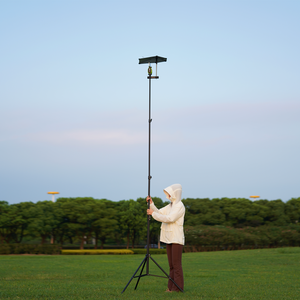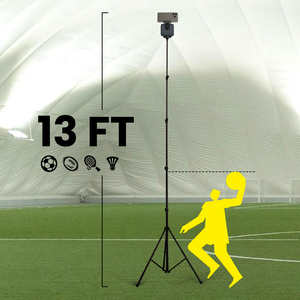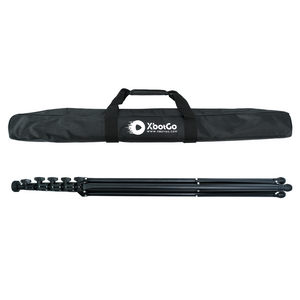XbotGo Chameleon AI Sports Camera
Altura del aro de baloncesto: la guía definitiva
¿Alguna vez has visto a LeBron James elevarse por los aires para una volcada espectacular y te has preguntado a qué altura está exactamente ese aro? No estás solo. Ya sea que estés resolviendo una discusión en un bar deportivo o ayudando a tu hijo a ajustar el aro de su jardín, conocer la altura exacta de un aro de baloncesto de la NBA es fundamental para todo aficionado al baloncesto.
La respuesta oficial: 10 pies sobre el suelo
Un aro de baloncesto de la NBA se encuentra exactamente a 3,05 metros (10 pies) de altura sobre la superficie de juego. Esta medida, tomada desde el suelo hasta la parte superior del aro, se ha mantenido inalterada desde que el Dr. James Naismith inventó el baloncesto en 1891. Todas las ligas profesionales del mundo, desde las relucientes canchas de la NBA hasta las competiciones internacionales de la FIBA, mantienen este mismo estándar.
Esta consistencia no es solo tradición; es la base que convierte al baloncesto en un deporte verdaderamente global. Cuando Giannis Antetokounmpo pasó de las ligas griegas a la NBA, o cuando Luka Dončić se pasó del baloncesto europeo a Dallas, no necesitaron recalibrar su tiro: el aro los esperaba a la misma altura.
La base histórica de la altura del aro de baloncesto
La altura perfecta accidental
Aquí tienes un dato curioso que podría hacerte ganar puntos: la altura de 3 metros no se eligió mediante una investigación científica exhaustiva ni pruebas atléticas. En diciembre de 1891, el Dr. James Naismith se enfrentó a un problema sencillo: necesitaba un lugar donde colgar cestas de melocotones para su nueva actividad invernal en interiores en la Escuela Internacional de Entrenamiento de la YMCA en Springfield, Massachusetts.
La pista de atletismo del gimnasio tenía una barandilla de 3 metros de altura. Naismith agarró un martillo, clavos y montó las cestas de melocotón en el balcón. No se imaginaba que esta conveniente altura se convertiría en uno de los estandartes deportivos más perdurables.
Cronología de la evolución de los aros de baloncesto
El recorrido desde las cestas de melocotón hasta las llantas rompedoras de alta tecnología de la actualidad cuenta una fascinante historia de innovación:
1891-1906: La era de las canastas de durazno. Esas canastas de durazno originales tenían bases cerradas. ¡Imagínese detener el juego cada vez que alguien anotaba para subir una escalera y recuperar la pelota! Los jugadores pronto se dieron cuenta de que esto no era sostenible, lo que dio lugar a la primera gran evolución del equipo.
1906-1940: La revolución de las llantas de metal
- Los aros de metal con redes de cadena reemplazaron las cestas.
- Los tableros de madera impidieron que los fanáticos demasiado entusiastas interfirieran
- La altura de 10 pies quedó oficialmente codificada en las reglas del baloncesto.
Década de 1940-1970: Vidrio y visibilidad
- Los tableros de vidrio transparente revolucionaron la experiencia del espectador
- Los jugadores desarrollaron tiros de banco y nuevas estrategias ofensivas.
- Las emisiones televisivas se beneficiaron de una mejor visibilidad
Década de 1970-presente: Seguridad y tecnología
- Los aros desmontables evitaron lesiones y daños al equipo (¡gracias a Darryl Dawkins y sus volcadas que rompieron el aro!)
- Los modernos sistemas de absorción de impactos protegen a los jugadores y al equipo.
- A pesar de todas estas innovaciones, esa altura de 10 pies permanece intacta.
Estandarización global: por qué es importante la consistencia
Estándares de la Liga Universal
Entra en cualquier estadio de baloncesto profesional del mundo y encontrarás el aro exactamente a 10 pies:
- NBA (Asociación Nacional de Baloncesto)
- WNBA (Asociación Nacional de Baloncesto Femenino)
- NCAA (baloncesto universitario masculino y femenino)
- FIBA (Federación Internacional de Baloncesto)
- Baloncesto de secundaria (mundial)
Esta estandarización crea un lenguaje universal para el baloncesto. Un jugador que entrena en un gimnasio polvoriento en Serbia desarrolla la misma memoria muscular que alguien que entrena en unas instalaciones de vanguardia en Los Ángeles. Esta consistencia ha sido fundamental para el explosivo crecimiento global del baloncesto.
Impacto internacional
Considere cómo esta estandarización afecta el desarrollo de jugadores a nivel mundial. Cuando estrellas internacionales como Dirk Nowitzki, Yao Ming o, más recientemente, Joel Embiid llegaron a la NBA, no se enfrentaron al reto adicional de adaptarse a diferentes alturas de aro. Sus habilidades se trasladaron directamente, permitiendo que su talento brillara de inmediato.
Este estándar universal también significa que el baloncesto olímpico, las competiciones de la Copa Mundial y otros torneos internacionales pueden contar con los mejores jugadores del mundo compitiendo en igualdad de condiciones. El aro de Tokio es idéntico al de París, que coincide con el de Los Ángeles.
Variaciones de altura según la edad: desarrollo progresivo de los jugadores
Pautas de altura para el baloncesto juvenil
Mientras que los profesionales juegan a 3 metros, el baloncesto juvenil adopta un enfoque más inteligente. Así es como la altura del aro aumenta a medida que los jugadores jóvenes se desarrollan:
De 5 a 7 años: 1,80 a 2,13 metros. En esta etapa, todo gira en torno a la diversión y los fundamentos. Los niños pueden encestar, ganando confianza mientras aprenden la técnica básica. Ver a un niño de 6 años encestar su primera canasta en un aro de 1,80 metros: esa sonrisa no tiene precio.
Edades 8-10: 2,5-2,7 metros. Aquí los jugadores empiezan a desarrollar técnicas de tiro reales. El aumento de altura los desafía sin sobrepasar su fuerza, que aún está en desarrollo. Aquí es donde verás a los niños pasar de lanzar la pelota a tirarla de verdad.
Edades 11-12: 2,7-3 metros. El período de transición crucial. Algunas ligas lo mantienen en 2,7 metros, mientras que otras lo hacen al nivel reglamentario completo. Esta edad suele determinar si los jugadores desarrollan una técnica de tiro adecuada o si compensan malos hábitos.
Mayores de 13 años: 3 metros (Regular) Bienvenidos a las grandes ligas, al menos en cuanto a la altura del aro. De ahora en adelante, ya sea jugando en secundaria, preparatoria o más allá, los jugadores se enfrentan al mismo reto de los 3 metros que los profesionales.
La ciencia detrás de Progressive Heights
Los científicos deportivos han validado este enfoque progresivo mediante una extensa investigación. Al iniciar a los niños en el baloncesto reglamentario, a menudo se les suele abusar del balón, utilizando una técnica incorrecta solo para alcanzar el aro. Estos malos hábitos se vuelven increíblemente difíciles de corregir más adelante. Al aumentar gradualmente la altura, los jóvenes jugadores desarrollan una mecánica de tiro adecuada que les servirá durante toda su trayectoria en el baloncesto.
Impacto en el rendimiento: cómo afecta la altura al juego
Consideraciones biomecánicas
La altura de 10 pies crea demandas físicas específicas que determinan cómo se juega al baloncesto:
Mecánica de disparo:
- Los jugadores deben generar un ángulo de liberación óptimo entre 45 y 50 grados.
- El arco del tiro se vuelve crucial para la consistencia.
- Los diferentes tipos de tiros (tiros de salto, bandejas, tiros libres) requieren técnicas distintas.
Requisitos atléticos: para encestar una pelota de baloncesto a 10 pies, la mayoría de los jugadores necesitan:
- Un salto vertical de al menos 28-30 pulgadas
- Sincronización precisa y control corporal
- Fuerza de la mano para controlar el balón en extensión completa
Desafíos defensivos:
- El bloqueo de tiros requiere una sincronización excepcional a esta altura.
- La posición de rebote se vuelve crucial cuando la pelota sale de un aro de 10 pies.
- La defensa debe tener en cuenta tanto los tiros desde el perímetro como la protección del aro.
Análisis de impacto estadístico
Los números cuentan la historia de cómo 10 pies crean el equilibrio competitivo perfecto:
- Porcentaje de tiros de campo de la NBA: ronda el 46-48 %
- Porcentaje de tiros libres: aproximadamente 75-78% del promedio de la liga
- Mates: Menos del 5% de todos los tiros de campo convertidos
- Porcentaje de tres puntos: aproximadamente 35-36% del promedio de la liga
Estas estadísticas revelan la genialidad de la altura de 3 metros. Es lo suficientemente alta como para ser un reto, incluso para atletas de élite, pero no tan alta como para que sea imposible anotar. Este equilibrio mantiene los partidos competitivos y entretenidos.
El gran debate: ¿Debería cambiar la altura del aro?
Argumentos para elevar el aro
Cada pocos años, generalmente después de que alguien consiga una volcada espectacular, el debate resurge. Los defensores argumentan:
- El atletismo de los jugadores modernos hace que el juego sea "demasiado fácil".
- Un borde más alto enfatizaría la habilidad sobre el tamaño.
- Podría reducir el riesgo de lesiones por colisiones cerca del borde.
- El juego volvería al baloncesto "puro" con más énfasis en los fundamentos.
Argumentos contra el cambio
Sin embargo, el consenso abrumador (de jugadores, entrenadores y administradores) se opone a cualquier cambio de altura:
Desarrollo del jugador: Todos los jugadores actuales, desde las superestrellas de la NBA hasta los jugadores más talentosos, aprendieron en aros de 3 metros. Cambiar ahora dejaría obsoletas décadas de memoria muscular y requeriría un reentrenamiento completo.
Costos de infraestructura: Consideremos cada canasta de baloncesto del mundo, desde los estadios de la NBA hasta los patios de recreo de las escuelas primarias. El costo de un reemplazo universal ascendería a miles de millones de dólares.
Valor de entretenimiento: A los aficionados les encantan las volcadas. A pesar de representar menos del 5% de las puntuaciones, generan entusiasmo en el público y momentos destacados virales. Elevar el aro eliminaría la posibilidad de que muchos jugadores las volquen, lo que reduciría el valor de entretenimiento.
Desequilibrio competitivo: Paradójicamente, elevar el aro podría aumentar la ventaja de los jugadores altos. Los bases más bajos que dependen del tiro exterior verían desplomarse sus porcentajes, mientras que los jugadores de 2,13 metros podrían seguir anotando desde dentro. El cambio perjudicaría precisamente a los jugadores a los que supuestamente busca ayudar.
Experimentos históricos
La comunidad del baloncesto no ha ignorado este debate. Varios experimentos han probado diferentes alturas:
Partido de exhibición Lakers vs. Hawks de 1954: Los equipos probaron aros de 3,6 metros en un partido especial. ¿El resultado? Pésimos porcentajes de tiro y un partido aburrido y de baja puntuación que convenció a todos de quedarse con los 3 metros.
Experimentos universitarios: Varias universidades han probado diferentes alturas en sus prácticas. Los jugadores informaron sistemáticamente que cualquier altura superior a 3 metros reducía drásticamente la puntuación y el ritmo del juego.
Aplicaciones de entrenamiento: Algunos entrenadores utilizan aros ajustables en la práctica (más bajos para generar confianza, más altos para entrenar la fuerza), pero siempre vuelven a los 10 pies para la preparación del juego.
Tecnología y documentación del baloncesto moderno
A medida que el baloncesto evoluciona en la era digital, la tecnología se adapta a las dimensiones estandarizadas del deporte. Los equipos modernos de filmación deportiva deben tener en cuenta la altura del aro de 3 metros al calcular los ángulos óptimos de cámara y los sistemas de seguimiento.
Las cámaras avanzadas con IA, como la XbotGo Chameleon, están calibradas específicamente para las dimensiones estándar de la cancha de baloncesto, incluyendo la altura del aro de 3 metros. Esta tecnología permite el seguimiento automático de los jugadores y ángulos de grabación óptimos, lo que garantiza que, ya sea que esté grabando el partido juvenil de su hijo o documentando un torneo amateur competitivo, la cámara comprenda las relaciones espaciales creadas por la altura reglamentaria del aro.
Consideraciones futuras: lo que nos espera
Posibles modificaciones en discusión
Aunque la altura del aro parece intocable, el baloncesto continúa evolucionando en otros aspectos:
Ampliación de la cancha: Algunos proponen ampliar las canchas para dar cabida a jugadores más grandes y rápidos. Esto generaría más espacio sin modificar la altura del aro.
Evolución de los triples: La NBA ya ha modificado la línea de tres puntos en varias ocasiones. Los ajustes futuros podrían seguir redefiniendo las estrategias ofensivas.
Innovación en equipos: Las nuevas tecnologías de aro y tablero podrían mejorar la seguridad y la durabilidad sin cambiar la sagrada altura de 10 pies.
Implicaciones económicas del cambio
Pongamos el impacto económico en perspectiva. Cambiar la altura de la llanta requeriría:
- Reemplazar todos los aros en todos los estadios de la NBA y universitarios
- Modificación de millones de aros de escuelas y parques en todo el mundo
- Rediseño de sistemas portátiles y ajustables
- Reentrenamiento de todos los jugadores en todos los niveles
Las estimaciones conservadoras estiman el costo global en miles de millones, sin contar los costos intangibles de interrumpir la continuidad del deporte.
Preservando la esencia del baloncesto
El aro de 3 metros conecta el pasado, el presente y el futuro del baloncesto. Cuando Zion Williamson realiza una volcada espectacular, ataca el mismo aro que Wilt Chamberlain dominó en la década de 1960. Esta continuidad permite realizar comparaciones estadísticas significativas entre épocas y preserva la integridad histórica del baloncesto.
En términos más filosóficos, la altura de 3 metros representa el equilibrio perfecto del baloncesto. Es lo suficientemente alcanzable como para que millones de personas puedan jugarlo recreativamente, pero a la vez lo suficientemente desafiante como para que incluso los profesionales deban esforzarse para dominarlo. Este equilibrio ideal entre accesibilidad y dificultad convierte al baloncesto tanto en un deporte local como en un deporte profesional global.
Conclusión
La próxima vez que veas un partido, ya sean los playoffs de la NBA o un partido informal en tu parque local, tómate un momento para apreciar la altura del aro. Son los mismos 3 metros que han desafiado a los jugadores durante generaciones y seguirán haciéndolo durante las próximas. En el baloncesto, algunas cosas vale la pena preservarlas tal como son, y el aro de 3 metros es el ejemplo perfecto de acertar a la primera.
XbotGo Chameleon AI Sports Camera
Capture every moment with AI-powered tracking. Perfect for coaches, parents, and athletes who want seamless footage without manual filming.







 Soccer
Soccer Basketball
Basketball Ice Hockey
Ice Hockey Rugby
Rugby










